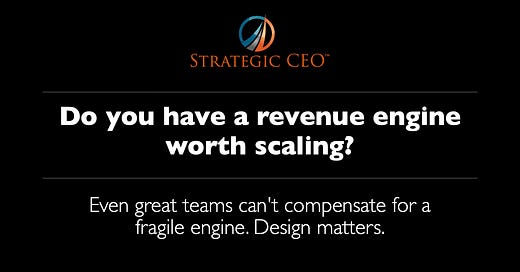Do you have a revenue engine worth scaling?
Even great teams can't compensate for a fragile engine. Design matters.
THINK ON IT: Do you have a revenue engine worth scaling?
Before you try to scale, stop and ask: Is what we’re scaling actually working?
It’s a critical question—one that many leaders I've worked with overlook in their rush for growth. But scaling a weak or misaligned revenue engine doesn’t fix the problem. It makes the problem permanent.
That’s why I believe a robust revenue engine isn’t the starting point of a growth strategy. It’s the necessary third lever. First, you need a resonant market focus—clear alignment with a buyer you deeply understand. Then, you need a bold offer—something meaningfully different and compelling enough to drive demand. Only then should you build the machine that delivers it.
Otherwise, you’re not scaling what works. You’re just scaling what exists.
And it’s easy to do so. It’s so much easier to focus on optimization than transformation. And when you do, it shows:
Revenue spikes unpredictably.
Sales cycles stretch longer than expected.
Forecasts are missed. Pipeline reviews become guesswork.
Top performers carry too much weight—and burnout looms.
But here’s the deeper problem: you may not realize your engine is fragile until it fails under pressure. A market shift, a lost account, or the departure of a rainmaker—and suddenly, what looked like momentum evaporates.
That’s the cost of building around people instead of systems. Around activity instead of design.
So, how can you tell if your revenue engine is truly robust?
Ask yourself:
Are we clear on why we win and why we lose—or do we just speculate?
If a key salesperson left tomorrow, would we still hit plan?
Are our marketing efforts repeatable—or reliant on creativity and luck?
Does each stage of the sales process build naturally from the last—or is it stitched together ad hoc?
Do we learn and adapt with each cycle—or does it feel like Groundhog Day?
If these questions surface any discomfort, that’s the point. Because a robust engine isn’t just about moving fast—it’s about moving forward with confidence.
Strategic CEOs don’t wait for breakdowns to rebuild. They don’t tolerate engines that lurch and stutter. They design their engines—intentionally, structurally—to be reliable, repeatable, resilient, and responsive to change.
You can’t always control the market. But you can control how well you’re built to meet it.
In the Act on It section below I suggest a framework for thinking about where your revenue engine might be today and how to make it more robust. (Premium Members only. Become a Premium Member. Paid subscribers get access to over 100 tools and how-tos on implementing strategic topics, including a 7-part series to help leaders build their own strategic capacity.)
“Every system is perfectly designed to get the results it gets.”
— W. Edwards Deming
Thanks for being a subscriber to Strategic CEO. If you enjoyed this post, please share it with a friend or colleague.
Keep reading with a 7-day free trial
Subscribe to Strategic CEO to keep reading this post and get 7 days of free access to the full post archives.



